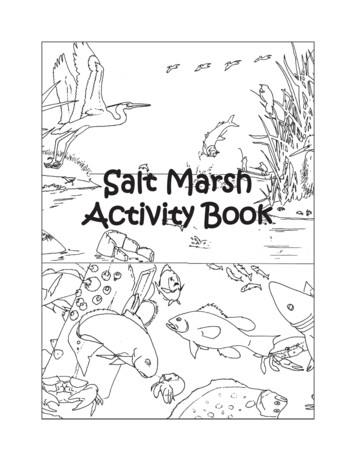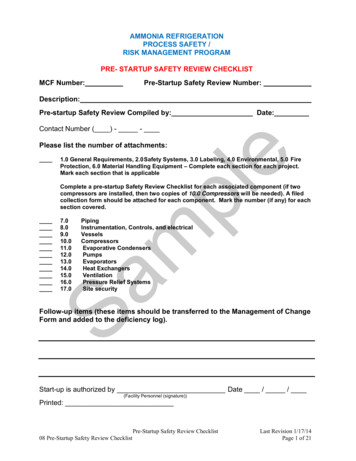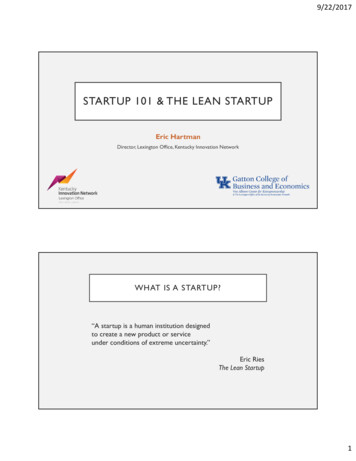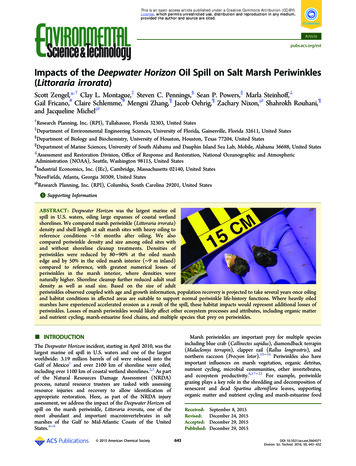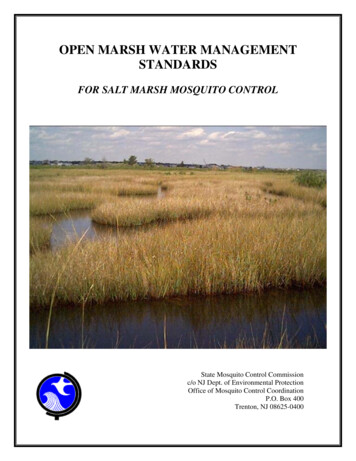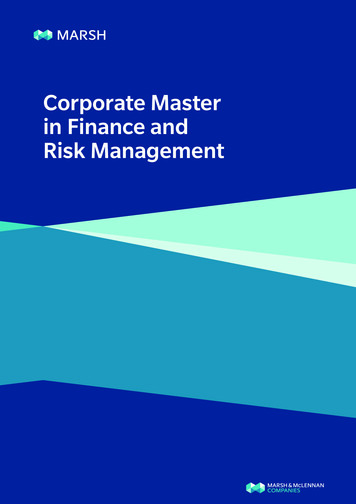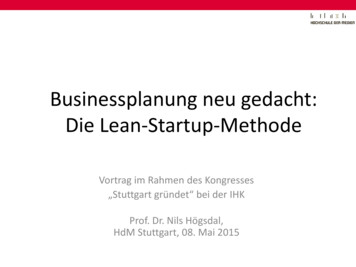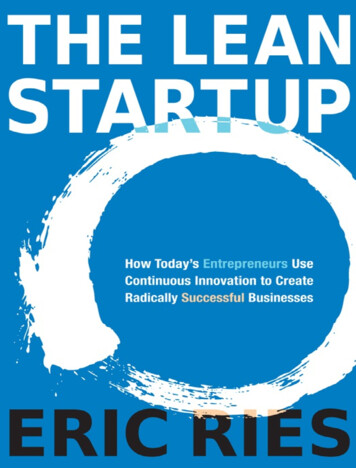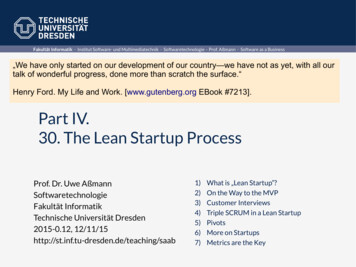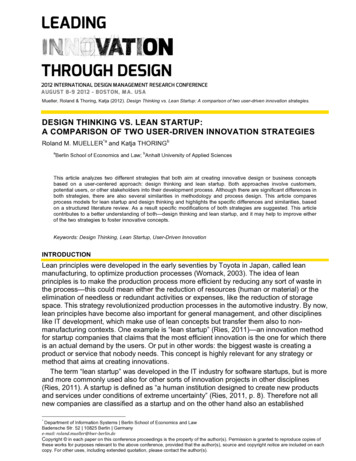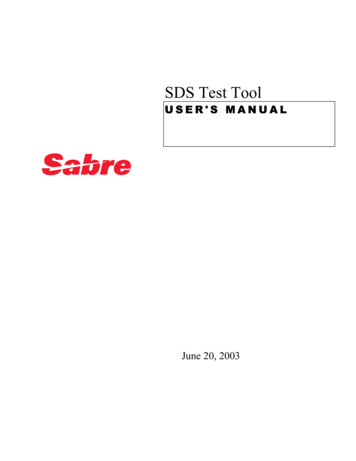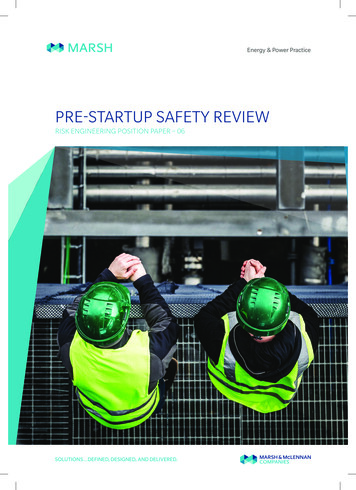
Transcription
Energy & Power PracticePRE-STARTUP SAFETY REVIEWRISK ENGINEERING POSITION PAPER – 06
CONTENTS1. Objective32. Background33. When to do a pre-startup safety review (PSSR)?54. Who carries out the PSSR?75. What are the steps in a PSSR?76. Stewardship of the PSSR?87. Use of PSSR forms and checklists88. References89. Appendix A101. Example PSSR form102. Example PSSR checklist (long)103. Example PSSR checklist (short)1610. Appendix BSelf-assessment checklist1818Marsh 1
2 Pre-Startup Safety Review
1. OBJECTIVEA pre-startup safety review (PSSR) is carried out to confirm that allappropriate elements of process safety management have beenaddressed satisfactorily and that the facility is safe tostartup.The objective of this position paper is to define the key attributesthat would be rated by Marsh as very good for a PSSR in the oil,gas and petrochemical industry. The attributes demonstratedin this Position Paper can be used to support and define riskimprovement recommendations and can also provide detailedadvice to clients seeking to improve their management systems.2. BACKGROUND2.2 HISTORICAL AND LEGAL SETTINGThe need for a PSSR, in concept, is not limited to the processindustry.There are many instances where a handover, or transitionbetween phases of a project or construction, require:a. A formal point at which contractual or organizationalresponsibilities may be passed from one group to another.b. Acknowledgement that due diligence has been carried out byboth the issuer and receiver prior to handover.c. Marking a critical milestone in determining the completion ofwork such that safe operations may commence.The concept of handover is implicit in a pre-startup safety review,and it provides the team taking over the opportunity to accept ordecline taking ownership until certain aspects are corrected.2.1 VALUE OF THE PSSR PROCESSStartup of new or modified equipment is a particularly vulnerabletime for safety incidents and other unplanned events whichcan cause significant loss, both financial loss and damage tohuman life and health. A number of elements of good processsafety management practice and capital project design includemeasures to reduce the risk of loss on startup. Such lossesinclude, but are not limited to, incidents involving fire, explosion,environmentally damaging spill or gaseous release, or incidentsinvolving injury to employees or members of the public. Poorlyplanned or executed startups can result in loss or wastage ofmaterials, and other inefficiencies which can damage profitability.Good management practices in this context include front endengineering design (FEED), construction practices, qualityassurance, process hazard analysis (PHA), management ofchange (MoC) and PSSR.The concept is formally recognized in the PSM regulations inthe USA (ref 1,2). While the regulations of other countries e.g.Seveso III in Europe, do not necessarily recognize PSSR by name,PSSR is clearly a good practice which contributes to deliveringthe duty of care required by these regulations to prevent andmitigate major accident hazards.2.3 RELEVANT INCIDENT SUMMARIESInadequate PSSR is often identified by incident investigatorsas a significant contributory cause. In the following summariesof two major incidents, PSSR was part of the parent companiesprocedures but was either not implemented or inadequatelyperformed. The investigations found that had PSSR been carriedout as intended the incidents would probably have been avoided.The PSSR provides a final checkpoint to confirm all appropriateelements of process safety management have been addressedsatisfactorily and that the facility is safe to startup. This includeschecking that all the action items from other design andconstruction processes are complete.Some projects may necessitate a number of PSSRs wheredifferent modules of process and utilities are brought intooperation at different stages of commissioning.Marsh 3
INCIDENT SUMMARY #1TEXAS CITY REFINERY FIREAND EXPLOSION – 2005In this incident 15 people were killed and 180 injured. Financial losses arereported to have exceeded USD 1.5 billion6. Houses were damaged as far awayas 1.2 km from the refinery. The US Chemical Safety Board investigation notedthat the company had a rigorous pre-startup procedure that required all startups,including after turnarounds, to go through a PSSR. However no PSSR wasconducted, due to unfamiliarity by the process safety coordinator. The generalPSSR procedure in place required that all non-essential personnel be removedfrom the unit during startup, but this was not considered and hence the15 contractors who subsequently died were allowed to continue working fromtheir trailer close to the raffinate splitter which was misoperated on startup.The accident investigation identified the following deficiencies which shouldhave been identified and corrected by application of an effective PSSR, each ofwhich contributed to the extent of the disaster: Non-essential personnel were not withdrawn from the area. Key instrumentation and equipment was identified as malfunctioning but was notrepaired. Insufficient training and review of startup procedures. Inadequate staffing, in particular in the control room during startup.INCIDENT SUMMARY #2PESTICIDE CHEMICAL RUNAWAYREACTION (WEST VIRGINIA) 2008In this incident two people were killed and eight injured. The subsequentinvestigation by the US Chemical Safety Board concluded that, although aPSSR had been carried out, it was inadequate, and that this was a significantcontributing factor in the incident.Deficiencies which should have been identified and corrected by application ofPSSR, each of which contributed to the extent of the disaster, included: New equipment was not tested and calibrated before startup. Inadequate training to operate the new unit and its distributed controlsystem (DCS). Malfunctioning equipment and inadequate checking of DCS operationand displays. Standard operating practices not revised to address information specific to thenew control system. Lack of sufficient technical coverage to support the startup.4 Pre-Startup Safety Review
3. WHEN TO DO A PSSR3.1 WHERE PSSR FITS WITHIN THE PLANT MODIFICATION PROCESSAPPROACH FOR SIMPLER PROJECTS:The PSSR “event” typically sits after construction completion and before the introduction of hazardous substances. Normally it isassociated with “handover” from the construction organization to plant operations. However, where a period of commissioning activitynot involving hazardous materials is anticipated, for example water testing, the site may choose to do the PSSR after the non-hazardouscommissioning is completed.PROJECTMechanicalCompletionFront EndEngineeringDesignScreening ReviewsHazardIdentificationStagegate PHA’sHazard and OperabilityStudiesDesign80-90%Completion etyReviewRisk Assessment on MoCby checklist, HAZOPProject/MoCClosureSTART-UPSMALL MODIFICATIONAPPROACH FOR COMPLEX PROJECTS:Larger capital projects will require several PSSRs. For example a PSSR before commissioning (“RFC – readiness for commissioning”),between commissioning and startup (“RFISU – readiness for initial startup”) and between startup and full hand over (“RFSU – readinessfor startup”).BasicEng.EDeleted Eng.PProcurementCConstructionPrecom – PreparationRFISURFSUCPrecom – ExecutionCom – PreparationPUNCH LISTBy Sub SystemRFCStartUpCom – ExecutionABCOperationsDTRANSFERFor complex projects a PSSR should be carried out before utilities are allowed into the plant. Steam and electricity, for example, are bothhazardous and sources of energy.Organizations may choose to adopt two different scales of PSSR, a shorter form for smaller changes and modifications, and a longer formfor larger projects involving a larger team to review.Marsh 5
3.2 CIRCUMSTANCES WHERE A PSSR ISAPPROPRIATEA PSSR is broadly beneficial where any change modifies theprocess safety information1. It is recommended that a PSSR becarried out prior to the commissioning or re-start step in thefollowing circumstances:a. Capital projects.b. Modified equipment.c. New valves or valve operation.3.3 WHAT IS NOT A PSSR?Excellent practices such as the process hazards analysis (PHA),MoC, construction checklists, punch lists, and operatingprocedures etc. do not comprise a PSSR, but they will contributeinputs to the PSSR.The MoC is a “request” to make a change and the road map inhow that change can be implemented safely. The PSSR is theverification step that the MoC, and other processes, were carriedout as prescribed and that the recommendations from the MoC,and those other processes such as punch listing, have beencompleted.d. New or modified control system.e. A new type of reactor or process vessel.f. New feedstock or catalyst.g. Startup after a turnaround (even if no modifications areinvolved).h. Startup after an emergency shutdown involving complexissues such as reactants being abnormally distributed betweenequipment.i. Significant process changes such as use of a new, different,catalyst.j. Other changes involving a change in process safetyinformation per the OSHA definition2.It can be beneficial to apply after emergency shutdowns andafter routine maintenance where the process system involved iscomplex.On many sites PSSR is a discrete step in the MoC process. Mostcases of MoC will require a PSSR. However depending on how anorganization practices MoC, there may be a need for PSSRs wherean MoC has not been required, for example in re-starting after aturnaround where no plant design of process condition changeshave been made other than extensive shutdown for inspection,catalyst replenishment, and repair. Conversely there can be MoCswhere PSSR is not appropriate. Consider, for example, a changein operating conditions within the design parameters, in orderto evaluate the effect on plant yield. This may well be coveredby a MoC, but PSSR is not essential.6 Pre-Startup Safety ReviewThe PSSR is not for the purpose of checking fundamental designparameters. It cannot be expected, for example, to answer thequestion “is fire protection adequate”. It can and should checkthat fire protection was considered in the design, that anyrecommendations made in respect of fire protection in previousdesign and process hazards reviews have been implemented, andit should sample the coverage and condition of fire protection asinstalled during the plant walkthrough.
4. WHO CARRIES OUTA PSSR?5. WHAT ARE THE KEYSTEPS IN A PSSR?4.1An organization should develop a written PSSR procedurerequiring the following steps:ASSIGNING A PSSR LEADERThe head of the operations section who will be managing theplant in future is generally recommended as the most appropriatePSSR leader. An alternative approach is that the project engineeris the leader. For non-capital projects the MoC Coordinator orhis delegate is normally the chairperson. It is essential that theleader have sufficient experience and leadership capability inprocess safety issues, and this aspect should determine the mostappropriate person to lead the review.Management should assign the PSSR leader and PSSR team afterconsideration of the complexity of the plant and the nature of thehazards involved.4.2ASSIGNING A PSSR TEAMThis must be a multi-disciplinary team.5.1 Identification of the need for a PSSR, sometimes referred to asthe trigger event, as identified in section 3.2 above.5.2 Assignment of a PSSR leader and team as indicated in section4.1 and 4.2 above.5.3 The PSSR team meeting to discuss the purpose of the PSSR,and review all the items on the PSSR checklist. This meeting isthe core of the PSSR process and leads to: A review of status of documentation on physical completion,procedures, training, piping and instrumentation diagrams(P&IDs) etc., as indicated in the example checklist in theappendices. A visit of the PSSR team to the actual installation to get visualconfirmation of readiness for startup.ESSENTIAL ROLES WHO SHOULD PARTICIPATE: Engineer responsible for the design of the project. Representative of the operations department which will takeover the facility. A visit to the control room to get visual confirmation of thereadiness of the control room for startup of the new parts of theinstallation. Completion of the PSSR checklist by the team (see section 7). Representative of the maintenance department. Coordinator of the MoC process. Listing of action items which need correction before orpotentially after startup. Requestor of the change or project facilitator or his designee.5.4 Team sign-off for one of the following scenarios:Optional participants, by title, depending on type of project andorganizational structure:a. Facility is ready to startup, or move to next phase. Instrumentation engineer.b. F acility may be started-up but there are some issues whichneed to be dealt with after startup. These issues will be listedin the PSSR checklist, with responsibilities. Process engineer. Industrial hygiene representative. Construction engineer. Safety department representative. Environmental specialist. Inspection department representative. Emergency response department representative.One person can serve multiple roles. For efficiency reasons theteam should comprise not less than three people and not morethan eight people.c. F acility may not be started up until some issues are dealtwith. These issues will be listed in the PSSR checklist withresponsibilities.5.5 A managerial sign-off that the plant is ready to startup, ormove to next phase. The manager may or may not be part ofthe PSSR team, but the input from the PSSR team will be his/her primary source of advice that the facility is not ready tostartup (see appendix A1 for suggested form).5.6 A ction tracking with regards to issues which need to be dealtwith after the PSSR. For organizations with central actiontracking systems, this central action tracking system shouldalso be used for the PSSR actions.Marsh 7
6. STEWARDSHIPThe health of the PSSR process should be monitored by trackingthe number of PSSRs and actions closed. There should be anaudit process to ensure that PSSRs are being appropriatelyconducted.6.1 PROCESS SAFETY PERFORMANCEINDICATORSTypical indicators which can be used in the context of PSSR are: Number of PSSRs.7. PSSR FORMCHECKLIST7.1 CHECKLISTSThe PSSR Checklist used will depend on the nature of the site’sprocesses and hazards. Typical examples, with a petrochemicalplant in mind, are shown in appendix A. A long form is given inappendix A2 and a short form in appendix A3.Key items in a checklist will include, but not limited to: Number of open actions and number of actions closed. All completions such as mechanical completion and punch listshave been completed and signed off.6.2 INTERNAL AUDIT A punch list for items for completion before or forconsideration for completion after startup.The audit would check, for example, that: Completion of operator training. There is a current PSSR procedure. Standard operating procedures have been revised if required. PSSRs are being conducted as required. Emergency operating procedures have been revisedif required. Actions generated by PSSRs are being completed and closed ina timely manner. Commissioning procedure for first startup includingconsideration of withdrawal of non-essential personnel, andadditional personnel to be available, staffing of adjacent areas. Process hazards analysis including HAZOPs available, andrequisite actions taken on the recommendations made inthe PHA. Any regulatory issues such as flaring notified to theregulator accordingly. PPE requirement defined, understood and available.It is recommended that the checklist items consist of items whichit is reasonable for the PSSR team to verify. Checklist items suchas “are all pressure relief valves adequately sized” or “has theconsequences of back-flow been considered” are to be avoidedin a PSSR checklist. The PSSR team can check that there arepressure relief valve design calculations, and they can checkthat there has been a process hazards analysis, and that all therecommendations have been addressed.A separate form to be completed at the conclusion of the PSSR isrecommended, whereby all outstanding actions are listed to becompleted before and after startup, with managerialsign-off that it is “OK” or “not OK” to startup. An exampleis shown in appendix A1. This form may be integrated withthe PSSR checklist.8 Pre-Startup Safety Review
7.2 SELECTION OF CHECKLIST TO BE USEDIt should be the responsibility of the manager who will sign offthe PSSR that the plant is ready to start, who decides whether theshort form or long form is the most appropriate checklist to use.In deciding which approach is most appropriate the manager willconsider the complexity of the plant, the nature of the hazards,and the experience and competence of the selected PSSR team.8. Marsh Position Paper, “Management of ange-moc.html7.3 MANAGERIAL SIGN OFFThe PSSR team will complete the checklist for the manager whowill determine finally if the equipment is ready to startup. Indoing this the PSSR team will list all the actions they considernecessary to be completed before startup, and those which canbe completed afterwards.The manager will then consider the findings of the pre-startupteam and decide if the plant is ready for startup. An exampleform for this purpose is shown in appendix A1.8. REFERENCES1. Process Safety Management of Highly Hazardous ChemicalsStandard, Title 29, Code of Federal Regulations (CFR)Part 1910.119 (FR 57(36):6356 - 6417, February 24, 1992).This contains the actual wording of the PSM rule.2. OSHA 3132 – Process Safety Management– An information book supporting reference 1.3. “Guidelines for Performing Effective Pre-Startup SafetyReviews”, Center for Chemical Process Safety (CCPS).ISBN: 978-0-470-13403 - Wiley (April 2007).4. CCPS Process Safety Beacon, December 2005,“Startup Hazards”.5. Implementation of Process Safety Management (PSM) inCapital Projects, C. Soczec, Du Pont Sustainable Solutions(2011).6. Investigation Report: Refinery Explosion and Fire(15 killed, 180 injured) BP Texas City, March 23, 2005.US Chemical Safety and Hazard Investigation Board ReportNo. 2005-04-I-TX March 2007.7. Investigation Report: Pesticide Chemical Runaway Reaction(two killed, eight injured) Bayer CropScience, Institute,West Virginia, August 28, 2008.US Chemical Safety and Hazard Investigation Board ReportNo. 2008-08-I-WV January 2011.Marsh 9
APPENDIXAPPENDIX A1 : EXAMPLE PSSR COMPLETION FORMPSSR FormDate:PSSR Team Leader:Facility Process Equipment Reviewed:Type of Startup:Check One:New EquipmentModified Existing EquipmentProcess ChangeAfter TurnaroundAfter Emergency ShutdownRecommendations essential to be completedbefore startupAssigned Responsible:Date Completed and SignatureRecommendations which may be completedafter startupPSSR completion: Except as mentioned by recommendations above the PSSR team believes the process/facility is ready for startup Construction and equipment meets design specifications. Safety, operating, maintenance, and emergency procedures are in place and areadequate. For new facilities a process hazards analysis has been performed andrecommendations resolved. Training of each employee involved in the operating process is complete. Changes made to modify the process/facility have been reviewed and authorizedby the facility management of change (MoC) program.PSSR Team MembersSignatures:ManagerProcess/facility is authorised to startup.Signature:10 Pre-Startup Safety Review
APPENDIX A2 : EXAMPLE PSSR CHECKLIST (LONG)This checklist is given for example only. Individual sites will need to modify or add to it according to their local circumstances, processand terminology. Only sample checklist questions are shown here.Ref :Project / MoC title:Site/area:IMPORTANT POINTS TO REMEMBER:1. PSSR must be conducted after mechanical completion and before commissioning and startup.2. Area owner representative shall lead the PSSR ( unless otherwise assigned to project leader or MoC coordinator).3. If answer to any of the checklist items is “no”, an action needs to be created for completion before or after startup.4. For temporary changes, a PSSR should be done before the change and again after restoration of the facility to its original state.5. The PSSR team is not expected to review the plant design or process hazards reviews. In response to the following checklist itemsthe PSSR team is expected to verify that the aspect was considered in the design, that any outstanding actions from the design andprocess hazards reviews have been completed, and to sample the facilities provided for their visual conformity to the needs described.Discipline Representative/ Engineer / Specialist / Inspector(note one person can fill multiple roles)2.1Operations specialist designate (PSSR team leader unlessotherwise assigned)2.2Project engineer2.3Mechanical maintenance2.3Electrical maintenance2.4Instrumententation and/or DCS specialist (if appropriate)2.5Process engineer2.6MoC coordinator (if MoC)2.7Operations representative2.8Initiator of the project or change2.8Inspection (if appropriate)2.9Construction engineer (if appropriate)2.10Safety department representative (if appropriate)2.11Environmental specialist (if appropriate)2.10Industrial hygiene/ergonomics specialist (if appropriate)2.11Others specify:PSSR Team NamesSIGNATUREDATEContinues overleaf.Marsh 11
ITEM#CHECK ITEMSYESN/AAGENERAL 1.Does equipment condition allow safe access for operation, inspection/maintenance? 2.Are pre-commissioning punch list items completed? 3Have adequate provisions been made for the technical or supervisorysupport during initial operation? 4Have spare parts been obtained? 10.Have all unwanted scaffoldings been removed? 11.Has availability of utilities been checked for safe startup? 12.Has communication been done with other facilities/units to ensure thatthey are operating in a way that it does not affect safe startup (e.g. supply offeedstock, flaring, utilities, emergency operations)? ITEM#CHECK ITEMSYESNON/ABDOCUMENTATION AND TRAINING 1Have standard operating procedures been provided? 2.Have any special procedures been provided (examples are samplingmethods, equipment lubrication etc.)? 3.Has standard operating procedure training been carried out? 4.Have safe operating limits been determined and available? 9.Have special procedures for commissioning or first-time startup beenprovided and reviewed? 10.Has this change been adequately communicated to adjacent units or otheraffected groups? 11.Has the plant plot plan been updated? 12.Have P&IDs, process flow diagrams (PFDs) and other applicable processsafety information key documents been “red-lined-marked” for changes?13. Have all inspection related documents/drawings, records and testing beenupdated (including positive materials identification)? 14.Have all the red-lined drawings being handed over in turn-over packages forall relevant disciplines? 15.Have training equipment needs been considered and purchased for thisproject? 16.Has vendor literature on equipment been filed properly in operation,inspection/maintenance areas? 17.Has the training been completed, documented, and input into the trainingrecords system? 12 Pre-Startup Safety ReviewNote any actionrequiredNote any actionrequiredYNLEOPLAMEXNO
ITEM#CHECK ITEMSYESN/ACSAFETY, HEALTH AND FIRE PROTECTION 1.Has safety equipment (e.g., fire extinguishers, fire detectors, eye baths,safety showers, breathing equipment, alarm boxes) been provided andlocated where needed? Have they been checked and are they operational? 2.Is unobstructed access to safety and fire protection equipment provided? 3.Is deluge water system provided, if required? 4.Have areas with potential for exposure to high noise levels been identifiedand warning signs put in place? 19.Have emergency response plans and scenarios been updated to reflect thenew facilities, and available at both the new/modified installation and at thefire and emergency response centers? Is ventilation in working order and inspected? Have the abandoned foundations and supports been removed to prevent triphazards? Are all openings in the platform adequately sized for pipe penetration andproperly banded? CHECK ITEMSYESNON/AWASTE STREAM AND ENVIRONMENT AND UTILITY SYSTEMS 1.Are bunding, draining, and curbing provided in accordance with design? 2.Have provisions been made for disposal of all wastes (i.e., drums, bags, filterelements, liquid residues)? 3.Will runoff rainwater be contained if it becomes chemically contaminated? 13.Have sewers been sealed correctly and vents adequately located? ITEM#CHECK ITEMSYESNON/AEPIPING, HOSES, VALVES AND VESSELS1.Have piping, valves and vessels been pressure tested?2.20.21.22.ITEM# Have cross-tied lines (pump headers, utility lines, etc.) been avoided wherecontamination, pressure, or temperature problems are likely? 3.Has a line-by-line review been conducted to ensure that the piping is installedas specified? 37.Have new fixed equipment such as pressure vessels, tanks, piping, hoses,injection points etc., been identified (tag numbered) and added to theinspection programs? 38.Is cathodic protection information available to be used for relevantpreventative maintenance and testing program? 39.Are there any pipeline dead-legs which might lead to corrosion or freezing?Have these been put on the inspection register? Note any actionrequiredNote any actionrequiredNote any actionrequiredYNLEOPLDAMEXNOMarsh 13
CHECK ITEMSYESNON/AFSAFETY & RELIEF FACILITIES 1.Have safety valves been inspected, tested and tagged? 2.Are block and bypass valves of safety valves car sealed? 3.Are relief devices directed away from personnel? 4.Is safety valve inlet and outlet piping supported to avoid undue stress on thesafety valve? 10.Are rupture discs correctly tagged? Are they installed facing the correctdirection with respect to flow? ITEM#CHECK ITEMSYESNON/AGROTATING AND MECHANICAL EQUIPMENT 1.Have special precautions for safe operation been adequately specified? 8.Is the drive unit grounded? 9.Have the lubricants and seal fluids been properly charged? ITEM#CHECK ITEMSYESNON/AHAMEX ELECTRICAL SYSTEMS 1.Have start/stop switches and electrical switchgear/Motor Control Centre(MCC) been properly labeled? 2.Can electrical equipment be isolated safely for repair work? 3.Do lockout provisions exist both at the switchgear/MCC and at the start/stopswitch? 4.Have conduit fittings been properly sealed? 5.Have electrical protective relays and safety devices been calibrated? 17.Has electrical equipment been designed and selected to meet hazardousarea classification requirements. 18.Does the electrical construction meet the plant standards? ITEM#CHECK ITEMSYESNON/AICONTROL SYSTEMS 1.Has the fail-safe function of valves been properly installed? Are mechanicalstops (if provided) are properly tested? 2.Are interlocks, alarms and logic provided in accordance with approvedspecifications? 13.Is instrument tubing adequately supported and leak tested? 14.Have bolts on explosion proof enclosures and conduits seals andcovers installed? 15.Do all the control system equipment, instrumentation and analyzerconstruction meet the plant standards? Note any actionrequiredNote any actionrequiredNote any actionrequiredYNLEO14 Pre-Startup Safety ReviewPLITEM#Note any actionrequired
PRINT NAME:JOB TITLE:DATE:SIGNATURE:Marsh 15
APPENDIX A3 EXAMPLE PSSR CHECKLIST (SHORT)This checklist is given for example only. Individual sites will need to modify or add to it according to theirlocal circumstances, process and terminology. Only sample checklist questions are shown here.PRE-STARTUP PROJECT SAFETY REVIEW CHECKLIST/APPROVALName of Dept.:Name of Project / MoC/ Project No.:Target Date for Startup:Name of Project Engineer/Manager:Signature:Name of Project Manufacturing Rep.:Signature:Name of Construction Engineer:Signature:Name of HSE Team ARTUPREQUIREDACTIONN/AYES All plant mechanicallyand electrically complete Operating proceduresupdated Operator trainingcompleted Action items from PHAscompleted PHA review completed Process technologyfiles updated includingoperating envelopes P&IDs marked up Safety equipment inplace MSDS book updated Emergency responseequipment andprocedures in place Production training Equipment files updatedand spares available Mechanical proceduresupdated Equipment, piping,safety valves etc.registered for inspection Mechanical trainingcompleted Scaffolding and othertemporary constructionequipment removed. Instrument & electrical(I&E) procedures anddocumentation updated PSSR Team walkthroughCompleted I&E training completed Maximum intendedinventory Emergency plan updated Electrical areaclassifications Action items fromconstruction punch listcompletedOperations Manager16 Pre-Startup Safety ReviewDateBEFORE/AFTERSTARTUP
PSSR Title:Date:Location:Attendees:PRINT NAME:JOB TITLE:DATE:SIGNATURE:Marsh 17
APPENDIX B: SELFASSESSMENT CHECKLISTThe following checklist is a quick tool that a site can use to test its existing processes against this good practice guide.Y1) SETUP AND APPLICABILITYDoes the site have a formal, written PSSR procedure?Does it clearly define when it is and is not applicable?Does it cover capital projects and MoCs?Does the process recognize the potential need for multiple PSSRsaccording to project stage?2) STAFFINGDoes the process define which organizational positions perform thekey roles of:–– PSSR l
The concept of handover is implicit in a pre-startup safety review, and it provides the team taking over the opportunity to accept or decline taking ownership until certain aspects are corrected. The concept is formally recognized in the PSM regulations in the USA (ref 1,2). While the regulations of other countries e.g.
